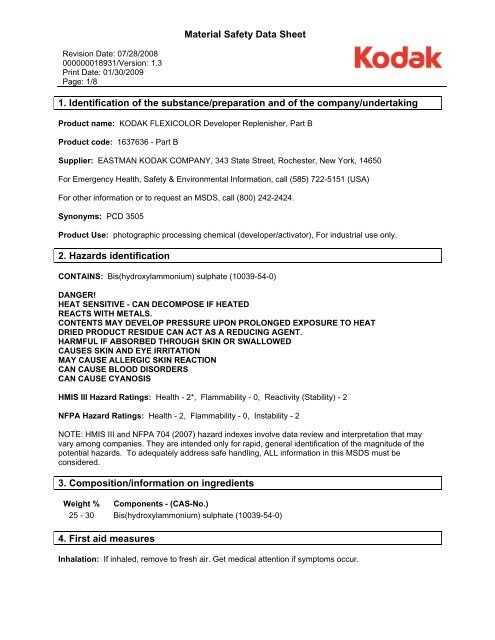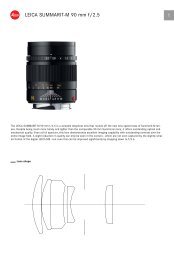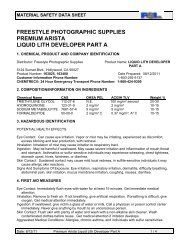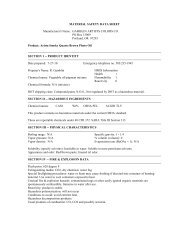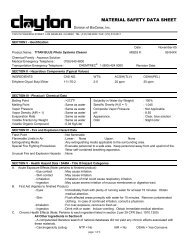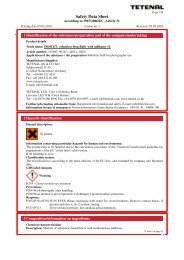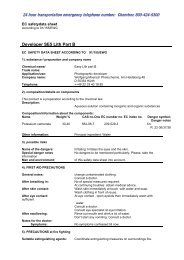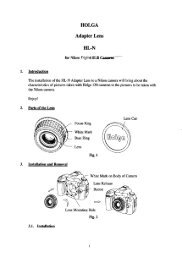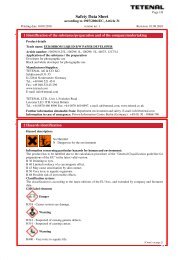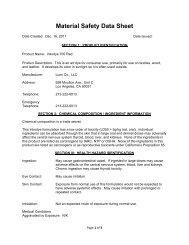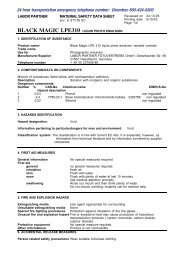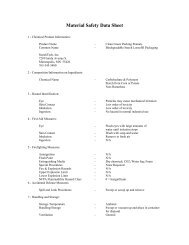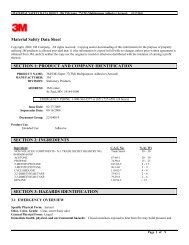Flexicolor C-41 Developer Replenisher Parts B&C makes 75 Gal.
Flexicolor C-41 Developer Replenisher Parts B&C makes 75 Gal.
Flexicolor C-41 Developer Replenisher Parts B&C makes 75 Gal.
You also want an ePaper? Increase the reach of your titles
YUMPU automatically turns print PDFs into web optimized ePapers that Google loves.
Revision Date: 07/28/2008<br />
000000018931/Version: 1.3<br />
Print Date: 01/30/2009<br />
Page: 1/8<br />
Material Safety Data Sheet<br />
1. Identification of the substance/preparation and of the company/undertaking<br />
Product name: KODAK FLEXICOLOR <strong>Developer</strong> <strong>Replenisher</strong>, Part B<br />
Product code: 1637636 - Part B<br />
Supplier: EASTMAN KODAK COMPANY, 343 State Street, Rochester, New York, 14650<br />
For Emergency Health, Safety & Environmental Information, call (585) 722-5151 (USA)<br />
For other information or to request an MSDS, call (800) 242-2424.<br />
Synonyms: PCD 3505<br />
Product Use: photographic processing chemical (developer/activator), For industrial use only.<br />
2. Hazards identification<br />
CONTAINS: Bis(hydroxylammonium) sulphate (10039-54-0)<br />
DANGER!<br />
HEAT SENSITIVE - CAN DECOMPOSE IF HEATED<br />
REACTS WITH METALS.<br />
CONTENTS MAY DEVELOP PRESSURE UPON PROLONGED EXPOSURE TO HEAT<br />
DRIED PRODUCT RESIDUE CAN ACT AS A REDUCING AGENT.<br />
HARMFUL IF ABSORBED THROUGH SKIN OR SWALLOWED<br />
CAUSES SKIN AND EYE IRRITATION<br />
MAY CAUSE ALLERGIC SKIN REACTION<br />
CAN CAUSE BLOOD DISORDERS<br />
CAN CAUSE CYANOSIS<br />
HMIS III Hazard Ratings: Health - 2*, Flammability - 0, Reactivity (Stability) - 2<br />
NFPA Hazard Ratings: Health - 2, Flammability - 0, Instability - 2<br />
NOTE: HMIS III and NFPA 704 (2007) hazard indexes involve data review and interpretation that may<br />
vary among companies. They are intended only for rapid, general identification of the magnitude of the<br />
potential hazards. To adequately address safe handling, ALL information in this MSDS must be<br />
considered.<br />
3. Composition/information on ingredients<br />
Weight % Components - (CAS-No.)<br />
25 - 30 Bis(hydroxylammonium) sulphate (10039-54-0)<br />
4. First aid measures<br />
Inhalation: If inhaled, remove to fresh air. Get medical attention if symptoms occur.
Revision Date: 07/28/2008<br />
000000018931/Version: 1.3<br />
Print Date: 01/30/2009<br />
Page: 2/8<br />
Material Safety Data Sheet<br />
Eyes: In case of contact, immediately flush eyes with plenty of water for at least 15 minutes. Get medical<br />
attention.<br />
Skin: In case of contact, immediately flush skin with plenty of water for at least 15 minutes while<br />
removing contaminated clothing and shoes. Get medical attention if symptoms occur. Wash contaminated<br />
clothing before re-use. Destroy or thoroughly clean contaminated shoes.<br />
Ingestion: If swallowed, DO NOT induce vomiting. Rinse mouth. Never give anything by mouth to an<br />
unconscious person. Call a physician or poison control centre immediately.<br />
Notes to physician:<br />
Treatment: Absorption of this material into the body leads to the formation of methemoglobin that, in<br />
sufficient concentration, causes cyanosis. Since reversion of methemoglobin to hemoglobin occurs<br />
spontaneously after termination of exposure, moderate degrees of cyanosis need to be treated only<br />
by supportive measures such as bed rest and oxygen inhalation. Thorough cleansing of the entire<br />
contaminated area of the body, including scalp and nails, is of utmost importance. If cyanosis is<br />
severe, intravenous injection of methylene blue, one milligram per kilogram of body weight, may be<br />
of value.<br />
5. Fire-fighting measures<br />
Extinguishing Media: Use extinguishing measures that are appropriate to local circumstances and the<br />
surrounding environment.<br />
Special Fire-Fighting Procedures: Wear self-contained breathing apparatus and protective clothing.<br />
Fire or excessive heat may produce hazardous decomposition products. Use water spray to cool<br />
unopened containers.<br />
Hazardous Combustion Products: None (noncombustible), (see also Hazardous Decomposition<br />
Products section).<br />
Unusual Fire and Explosion Hazards: Mixture contains a strong reducing agent. Reacts violently with<br />
oxidizing materials. Dried product residue can act as a reducing agent. May cause spontaneous heating<br />
and ignition when absorbed on combustible, porous material (e.g. rags, paper, sawdust, cotton, clothing).<br />
Elevated temperature can cause decomposition.<br />
6. Accidental release measures<br />
Absorb spill with vermiculite or other inert material. Collect in a noncombustible container for prompt<br />
disposal. Clean surface thoroughly to remove residual contamination.<br />
For Large Spills: Flush with plenty of water. Do not store in metal containers.<br />
7. Handling and storage<br />
Personal precautions: Avoid prolonged or repeated breathing of mist or vapour. Avoid contact with<br />
eyes, skin, and clothing. Use only with adequate ventilation. Wash thoroughly after handling.
Revision Date: 07/28/2008<br />
000000018931/Version: 1.3<br />
Print Date: 01/30/2009<br />
Page: 3/8<br />
Material Safety Data Sheet<br />
Prevention of Fire and Explosion: Keep away from heat and flame. Keep from any contact with metals.<br />
Remove and wash contaminated clothing promptly. Exercise caution if heating, especially in a closed<br />
container. Keep from contact with oxidizing materials, highly oxygenated or halogenated solvents, organic<br />
compounds containing reducible functional groups.<br />
Storage: Store in original container. Do not store in metal containers. Contents may develop pressure<br />
upon prolonged exposure to heat. Store in cool place. Keep container tightly closed to prevent the loss of<br />
water. Keep away from incompatible substances (see Incompatibility section.)<br />
8. Exposure controls/personal protection<br />
Occupational exposure controls: Not established<br />
Ventilation: Good general ventilation should be used. Ventilation should be sufficient so that applicable<br />
occupational exposure limits are not exceeded. Ventilation rates should be matched to conditions.<br />
Supplementary local exhaust ventilation, closed systems, or respiratory protection may be needed in<br />
special circumstances.<br />
Respiratory protection: If engineering controls do not maintain airborne concentrations to an<br />
acceptable level, an approved respirator must be worn. Respirator type: air-supplied respirator. If<br />
respirators are used, a program should be instituted to assure compliance with applicable federal, state,<br />
commonwealth, provincial, or local laws and regulations.<br />
Eye protection: Wear safety glasses with side shields (or goggles).<br />
Hand protection: Wear impervious gloves and protective clothing appropriate for the risk of exposure.<br />
9. Physical and chemical properties<br />
Physical form: liquid<br />
Colour: colourless<br />
Odour: odourless<br />
Specific gravity: 1.16<br />
Vapour pressure (at 20.0 °C (68.0 °F)) : 24 mbar (18.0 mm Hg)<br />
Vapour density: 0.6<br />
Volatile fraction by weight: 70 - <strong>75</strong> %<br />
Boiling point/boiling range: decomposes before boiling<br />
Water solubility: complete<br />
pH: 3.0<br />
Flash point: does not flash
Revision Date: 07/28/2008<br />
000000018931/Version: 1.3<br />
Print Date: 01/30/2009<br />
Page: 4/8<br />
Flammability Limits: Not specified<br />
10. Stability and reactivity<br />
Material Safety Data Sheet<br />
Stability: Stable in glass and plastic containers, however, becomes unstable in contact with metals.<br />
Materials containing similar structural groups can decompose if heated above 110°C (230°F). Safe<br />
handling temperatures are dependent on specific conditions of use and are typically substantially below<br />
the onset temperature. Consult your technical safety experts.<br />
Incompatibility: Acids, Halogenated compounds, Metals, Strong oxidizing agents. Material not stable in<br />
contact with metals.<br />
Hazardous decomposition products: Ammonia, sulphur dioxide, nitrogen oxides (NOx).<br />
Hazardous Polymerization: Hazardous polymerisation does not occur.<br />
11. Toxicological information<br />
Effects of Exposure<br />
General advice:<br />
Contains: Bis(hydroxylammonium) sulphate. Can cause blood disorders. Can cause cyanosis.<br />
There is limited evidence of carcinogenicity in lifetime oral studies in rats.<br />
Inhalation: Expected to be a low hazard for recommended handling.<br />
Eyes: Causes eye irritation. Airborne dust/mist/vapor irritating.<br />
Skin: Harmful if absorbed through skin. Causes skin irritation. May cause allergic skin reaction<br />
based on human experience.<br />
Ingestion: Harmful if swallowed.<br />
Data for Bis(hydroxylammonium) sulphate (CAS 10039-54-0):<br />
Acute Toxicity Data:<br />
• Oral LD50 (rat): 100 - 200 mg/kg<br />
• Oral LD50 (male rat): 100 - 200 mg/kg<br />
• Dermal LD50: > 1,000 mg/kg<br />
• Dermal study (24 hours): 10 mg/kg (target organ effects: red blood cell)<br />
• Dermal LD50 (guinea pig): > 1,000 mg/kg<br />
• Skin irritation: strong<br />
• Skin Sensitization (guinea pig): strong<br />
• Eye irritation: slight<br />
12. Ecological information<br />
The following properties are ESTIMATED from the components of the preparations.
Revision Date: 07/28/2008<br />
000000018931/Version: 1.3<br />
Print Date: 01/30/2009<br />
Page: 5/8<br />
Potential Toxicity:<br />
Material Safety Data Sheet<br />
Toxicity to fish (LC50): 10 - 100 mg/l<br />
Toxicity to daphnia (EC50): 1 - 10 mg/l<br />
Toxicity to algae (IC50): > 100 mg/l<br />
Toxicity to other organisms (EC50): 10 - 100 mg/l (sludge)<br />
Persistence and degradability: no data available<br />
Chemical Oxygen Demand (COD): ca. 133 g/l<br />
Biochemical Oxygen Demand (BOD): ca. 10 g/l<br />
13. Disposal considerations<br />
Discharge, treatment, or disposal may be subject to federal, state, commonwealth, provincial, or local<br />
laws. Since emptied containers retain product residue, follow label warnings even after container is<br />
emptied.<br />
14. Transport information<br />
The information given below is provided to assist in documentation. It may supplement the information on<br />
the package. The package in your possession may carry a different version of the label depending on the<br />
date of manufacture. Depending on inner packaging quantities and packaging instructions, it may be<br />
subject to specific regulatory exceptions. Please consult the product packaging for further details.<br />
IATA: UN Number: UN3264<br />
Proper shipping name: Corrosive liquid, acidic, inorganic, n.o.s.<br />
(Bis(hydroxylammonium) sulphate)<br />
Class: 8<br />
Packaging group: III<br />
IMDG: UN Number: UN3264<br />
Proper shipping name: CORROSIVE LIQUID, ACIDIC, INORGANIC, N.O.S.<br />
(Bis(hydroxylammonium) sulphate)<br />
Class: 8<br />
Packaging group: III<br />
US DOT: UN Number: UN3264<br />
Proper shipping name: Corrosive liquid, acidic, inorganic, n.o.s.<br />
(Bis(hydroxylammonium) sulphate)<br />
Class: 8<br />
Packaging group: III<br />
For more transportation information, go to: www.kodak.com/go/ship.<br />
15. Regulatory information
Revision Date: 07/28/2008<br />
000000018931/Version: 1.3<br />
Print Date: 01/30/2009<br />
Page: 6/8<br />
Notification status<br />
Material Safety Data Sheet<br />
Regulatory List Notification status<br />
EINECS y (positive listing)<br />
TSCA y (positive listing)<br />
AICS y (positive listing)<br />
DSL y (positive listing)<br />
ENCS (JP) y (positive listing)<br />
KECI (KR) y (positive listing)<br />
PICCS (PH) y (positive listing)<br />
INV (CN) y (positive listing)<br />
A N (Negative listing) indicates one or more component is either not on the public Inventory or is<br />
subject to exemption requirements. If additional information is needed contact Kodak.<br />
Other regulations<br />
American Conference of Governmental Industrial Hygienists<br />
(ACGIH):<br />
No component of this product present at<br />
levels greater than or equal to 0.1% is<br />
identified as a carcinogen or potential<br />
carcinogen by ACGIH.<br />
International Agency for Research on Cancer (IARC): No component of this product present at<br />
levels greater than or equal to 0.1% is<br />
identified as probable, possible or<br />
confirmed human carcinogen by IARC.<br />
U.S. National Toxicology Program (NTP): No component of this product present at<br />
levels greater than or equal to 0.1% is<br />
identified as a known or anticipated<br />
carcinogen by NTP.<br />
U.S. Occupational Safety and Health Administration (OSHA): No component of this product present at<br />
levels greater than or equal to 0.1% is<br />
identified as a carcinogen or potential<br />
carcinogen by OSHA.<br />
California Prop. 65: This product does not contain any<br />
chemicals known to State of California<br />
to cause cancer, birth, or any other<br />
reproductive defects.<br />
US. EPA Emergency Planning and Community Right-To-Know Act<br />
(EPCRA) SARA Title III Section 313 Toxic Chemicals (40 CFR<br />
372.65) - Supplier Notification Required:<br />
US. EPA Emergency Planning and Community Right-To-Know Act<br />
(EPCRA) SARA Title III Section 302 Extremely Hazardous<br />
Substance (40 CFR 355, Appendix A):<br />
SARA 313: This material does not contain<br />
any chemical components with known<br />
CAS numbers that exceed the<br />
threshold (De Minimis) reporting levels<br />
established by SARA Title III, Section<br />
313.<br />
SARA 302: No chemicals in this material<br />
are subject to the reporting<br />
requirements of SARA Title III, Section<br />
302.
Revision Date: 07/28/2008<br />
000000018931/Version: 1.3<br />
Print Date: 01/30/2009<br />
Page: 7/8<br />
Material Safety Data Sheet<br />
US. Pennsylvania Worker and Community Right-to-Know Law (34<br />
Pa. Code Chap. 301-323):<br />
US. Massachusetts Commonwealth's Right-to-Know Law<br />
(Appendix A to 105 Code of Massachusetts Regulations<br />
Section 670.000):<br />
US. New Jersey Worker and Community Right-to-Know Act (New<br />
Jersey Statute Annotated Section 34:5A-5):<br />
16. Other information<br />
Water, Bis(hydroxylammonium) sulphate<br />
No components are subject to the<br />
Massachusetts Right to Know Act.<br />
Water, Bis(hydroxylammonium) sulphate<br />
The data below reflects current legislative requirements whereas the product in your possession may<br />
carry a different version of the label depending on the date of manufacture.<br />
US/Canadian Label Statements:<br />
CONTAINS: Bis(hydroxylammonium) sulphate (10039-54-0)<br />
DANGER!<br />
HEAT SENSITIVE - CAN DECOMPOSE IF HEATED<br />
REACTS WITH METALS.<br />
CONTENTS MAY DEVELOP PRESSURE UPON PROLONGED EXPOSURE TO HEAT<br />
DRIED PRODUCT RESIDUE CAN ACT AS A REDUCING AGENT.<br />
HARMFUL IF ABSORBED THROUGH SKIN OR SWALLOWED<br />
CAUSES SKIN AND EYE IRRITATION<br />
MAY CAUSE ALLERGIC SKIN REACTION<br />
CAN CAUSE BLOOD DISORDERS<br />
CAN CAUSE CYANOSIS<br />
Keep container tightly closed to prevent the loss of water.<br />
Store in a cool place.<br />
Keep away from heat and flame.<br />
Exercise caution if heating, especially in a closed container.<br />
Avoid all contact with metal.<br />
Store in original tightly closed container.<br />
Keep from contact with clothing and other materials. Remove and wash contaminated clothing<br />
promptly.<br />
Avoid prolonged or repeated breathing of mist or vapour.<br />
Avoid contact with eyes, skin, and clothing.<br />
Use only with adequate ventilation.<br />
Wash thoroughly after handling.<br />
FIRST AID: If inhaled, remove to fresh air. Get medical attention if symptoms occur. In case of<br />
contact, immediately flush eyes with plenty of water for at least 15 minutes. Get medical attention. In<br />
case of contact, immediately flush skin with plenty of water for at least 15 minutes while removing<br />
contaminated clothing and shoes. Get medical attention if symptoms occur. Wash contaminated<br />
clothing before re-use. Destroy or thoroughly clean contaminated shoes. If swallowed, DO NOT<br />
induce vomiting. Rinse mouth. Never give anything by mouth to an unconscious person. Call a<br />
physician or poison control centre immediately.<br />
Notes to physician: Absorption of this material into the body leads to the formation of<br />
methemoglobin that, in sufficient concentration, causes cyanosis. Since reversion of methemoglobin
Revision Date: 07/28/2008<br />
000000018931/Version: 1.3<br />
Print Date: 01/30/2009<br />
Page: 8/8<br />
Material Safety Data Sheet<br />
to hemoglobin occurs spontaneously after termination of exposure, moderate degrees of cyanosis<br />
need to be treated only by supportive measures such as bed rest and oxygen inhalation. Thorough<br />
cleansing of the entire contaminated area of the body, including scalp and nails, is of utmost<br />
importance. If cyanosis is severe, intravenous injection of methylene blue, one milligram per kilogram<br />
of body weight, may be of value.<br />
Keep out of reach of children.<br />
Do not handle or use until safety precautions in Material Safety Data Sheet (MSDS) have been read<br />
and understood.<br />
Since emptied containers retain product residue, follow label warnings even after container is<br />
emptied.<br />
IN CASE OF FIRE: Use extinguishing measures that are appropriate to local circumstances and the<br />
surrounding environment.<br />
IN CASE OF SPILL: Absorb spill with vermiculite or other inert material. Collect in a noncombustible<br />
container for prompt disposal. Clean surface thoroughly to remove residual contamination. For Large<br />
Spills: Flush with plenty of water. Do not store in metal containers.<br />
The information contained herein is furnished without warranty of any kind. Users should consider these<br />
data only as a supplement to other information gathered by them and must make independent<br />
determinations of suitability and completeness of information from all sources to assure proper use and<br />
disposal of these materials and the safety and health of employees and customers and the protection of<br />
the environment. The information relating to the working solution is for guidance purposes only, and is<br />
based on correct mixing and use of the product according to instructions.<br />
R-1, S-3, F-0, C-2HT
Revision Date: 08/06/2008<br />
000000018946/Version: 1.4<br />
Print Date: 01/30/2009<br />
Page: 1/8<br />
Material Safety Data Sheet<br />
1. Identification of the substance/preparation and of the company/undertaking<br />
Product name: KODAK FLEXICOLOR <strong>Developer</strong> <strong>Replenisher</strong>, Part C<br />
Product code: 1637636 - Part C<br />
Supplier: EASTMAN KODAK COMPANY, 343 State Street, Rochester, New York, 14650<br />
For Emergency Health, Safety & Environmental Information, call (585) 722-5151 (USA)<br />
For other information or to request an MSDS, call (800) 242-2424.<br />
Synonyms: PCD 3513<br />
Product Use: photographic processing chemical (developer/activator), For industrial use only.<br />
2. Hazards identification<br />
CONTAINS: 4-(N-ethyl-N-2-hydroxyethyl)-2-methylphenylenediamine sulfate (25646-77-9), Sodium<br />
bisulphite (7631-90-5)<br />
DANGER!<br />
POISON<br />
MAY BE FATAL IF SWALLOWED<br />
MAY BE HARMFUL IF INHALED<br />
CAUSES SKIN AND EYE IRRITATION<br />
MAY CAUSE ALLERGIC SKIN REACTION<br />
DUST, MIST OR VAPOUR IRRITATING TO THE EYES AND RESPIRATORY TRACT<br />
MAY CAUSE KIDNEY DAMAGE BASED ON ANIMAL DATA<br />
HEAT SENSITIVE - CAN DECOMPOSE IF HEATED<br />
MAY LIBERATE SULFUR DIOXIDE<br />
THE PHYSICAL-CHEMICAL PROPERTIES OF THIS MATERIAL HAVE NOT BEEN FULLY<br />
INVESTIGATED<br />
HMIS III Hazard Ratings: Health - 3*, Flammability - 1, Reactivity (Stability) - 1<br />
NFPA Hazard Ratings: Health - 3, Flammability - 1, Instability - 1<br />
NOTE: HMIS III and NFPA 704 (2007) hazard indexes involve data review and interpretation that may<br />
vary among companies. They are intended only for rapid, general identification of the magnitude of the<br />
potential hazards. To adequately address safe handling, ALL information in this MSDS must be<br />
considered.<br />
3. Composition/information on ingredients<br />
Weight % Components - (CAS-No.)<br />
35 - 50 4-(N-ethyl-N-2-hydroxyethyl)-2-methylphenylenediamine sulfate (25646-77-9)<br />
1 - 5 Sodium bisulphite (7631-90-5)
Revision Date: 08/06/2008<br />
000000018946/Version: 1.4<br />
Print Date: 01/30/2009<br />
Page: 2/8<br />
4. First aid measures<br />
Material Safety Data Sheet<br />
Inhalation: If inhaled, remove to fresh air. Get medical attention.<br />
Eyes: In case of contact, immediately flush eyes with plenty of water for at least 15 minutes. Get medical<br />
attention.<br />
Skin: In case of contact, immediately flush skin with plenty of water for at least 15 minutes while<br />
removing contaminated clothing and shoes. Get medical attention if symptoms occur. Wash contaminated<br />
clothing before re-use. Destroy or thoroughly clean contaminated shoes.<br />
Ingestion: If swallowed, only induce vomiting as directed by medical personnel. Never give anything by<br />
mouth to an unconscious person. Call a physician or poison control centre immediately.<br />
5. Fire-fighting measures<br />
Extinguishing Media: Use water spray, alcohol-resistant foam, dry chemical or carbon dioxide.<br />
Special Fire-Fighting Procedures: Wear self-contained breathing apparatus and protective clothing.<br />
Fire or excessive heat may produce hazardous decomposition products. Use water spray to cool<br />
unopened containers.<br />
Hazardous Combustion Products: Carbon oxides, Sulphur oxides, nitrogen oxides (NOx), (see also<br />
Hazardous Decomposition Products section).<br />
Unusual Fire and Explosion Hazards: Elevated temperature can cause decomposition.<br />
6. Accidental release measures<br />
Absorb spill with inert material, then place in a chemical waste container. Clean surface thoroughly to<br />
remove residual contamination.<br />
7. Handling and storage<br />
Personal precautions: Do not breathe vapours or spray mist. Avoid contact with eyes, skin, and<br />
clothing. Keep container tightly closed. Use only with adequate ventilation. Wash thoroughly after<br />
handling. Do not eat, drink or smoke when using this product.<br />
Prevention of Fire and Explosion: Keep away from heat and sources of ignition. Keep from contact<br />
with oxidizing materials.<br />
Storage: Store in cool place. Keep container tightly closed. Keep away from incompatible substances<br />
(see Incompatibility section.)<br />
8. Exposure controls/personal protection<br />
Occupational exposure controls<br />
Chemical Name Regulatory List Value Type Value<br />
4-(N-ethyl-N-2- EK HPG Time Weighted Average (TWA): 0.1 mg/m3
Revision Date: 08/06/2008<br />
000000018946/Version: 1.4<br />
Print Date: 01/30/2009<br />
Page: 3/8<br />
Material Safety Data Sheet<br />
hydroxyethyl)-2methylphenylenediami<br />
ne sulfate<br />
Sodium bisulphite ACGIH time weighted average 5 mg/m3<br />
Sulphur dioxide ACGIH time weighted average 2 ppm<br />
ACGIH Short term exposure limit 5 ppm<br />
OSHA Z1 Permissible exposure limit 5 ppm 13 mg/m3<br />
Ventilation: Use process enclosures, local exhaust ventilation, or other engineering controls to maintain<br />
airborne levels below recommended exposure limits. Controls should be sufficient so that applicable<br />
occupational exposure limits are not exceeded.<br />
Respiratory protection: If engineering controls do not maintain airborne concentrations below<br />
recommended exposure limits, an approved respirator must be worn. Respirator type: Acid gas. If<br />
respirators are used, a program should be instituted to assure compliance with applicable federal, state,<br />
commonwealth, provincial, or local laws and regulations.<br />
Eye protection: Wear safety glasses with side shields (or goggles).<br />
Hand protection: Wear impervious gloves and protective clothing appropriate for the risk of exposure.<br />
9. Physical and chemical properties<br />
Physical form: liquid<br />
Colour: pale yellow<br />
Odour: strong sulphur dioxide<br />
Specific gravity: 1.15 - 1.18<br />
Vapour pressure (at 20.0 °C (68.0 °F)) : 24 mbar (18.0 mm Hg)<br />
Vapour density: 0.6<br />
Volatile fraction by weight: 50 - 65 %<br />
Boiling point/boiling range: > 100 °C (212.0 °F)<br />
Water solubility: complete<br />
pH: 2.1<br />
Flash point: > 93.33 °C (> 200.0 °F) (estimated)<br />
Flammability Limits: Not specified<br />
10. Stability and reactivity<br />
Stability: Not fully evaluated. Materials containing similar structural groups can decompose if heated.
Revision Date: 08/06/2008<br />
000000018946/Version: 1.4<br />
Print Date: 01/30/2009<br />
Page: 4/8<br />
Material Safety Data Sheet<br />
Incompatibility: Strong oxidizing agents, Strong bases, Acids. Contact with strong acids may liberate<br />
sulphur dioxide.<br />
Hazardous decomposition products: nitrogen oxides (NOx), Sulphur oxides.<br />
Hazardous Polymerization: Hazardous polymerisation does not occur.<br />
11. Toxicological information<br />
Effects of Exposure<br />
General advice:<br />
Contains: 4-(N-ethyl-N-2-hydroxyethyl)-2-methylphenylenediamine sulfate. May cause kidney<br />
damage based on animal data.<br />
Inhalation: May be harmful if inhaled. Airborne dust/mist/vapor irritating. Liberates sulphur dioxide<br />
gas which can cause irritation to the respiratory tract. Some asthmatics or hypersensitive individuals<br />
may experience difficulty breathing.<br />
Eyes: Causes eye irritation. Airborne dust/mist/vapor irritating.<br />
Skin: Causes skin irritation. May cause allergic skin reaction based on human experience.<br />
Ingestion: May be fatal if swallowed. Causes irritation of the gastrointestinal tract. Some asthmatics<br />
or sulfite-sensitive individuals may experience wheezing, chest tightness, stomach upset, hives,<br />
faintness, weakness and diarrhea.<br />
Data for 4-(N-ethyl-N-2-hydroxyethyl)-2-methylphenylenediamine sulfate (CAS 25646-77-<br />
9):<br />
Acute Toxicity Data:<br />
• Oral LD50 (male rat): 25 - 50 mg/kg (target organ effects: kidney)<br />
• Oral LD50 (female rat): 30 mg/kg (target organ effects: kidney)<br />
• Oral LD50: 1<strong>41</strong> mg/kg (target organ effects: kidney)<br />
• Inhalation LC50 (rat): > 164 mg/m3 / 6 hr<br />
• Dermal absorption rate (rat): 93.7 microgram(s)/cm2/hour (in vitro)<br />
• Dermal LD50: > 2,000 mg/kg<br />
• Skin irritation: moderate<br />
• Skin irritation: moderate irritation (repeated skin application)<br />
• Skin Sensitization (human): positive<br />
• Skin Sensitization (guinea pig): moderate to strong<br />
• Eye irritation (unwashed eyes): moderate<br />
• Eye irritation (washed eyes): slight<br />
Definitions for the following section(s): LOEL =lowest-observed-effect level, LOAEL = lowestobserved-adverse-effect,<br />
NOAEL = no observed-adverse-effect level, NOEL =no-observed-effect<br />
level.<br />
Repeated dose toxicity:
Revision Date: 08/06/2008<br />
000000018946/Version: 1.4<br />
Print Date: 01/30/2009<br />
Page: 5/8<br />
Material Safety Data Sheet<br />
• Oral (4 weeks, female rat): NOEL; 1 mg/kg/day<br />
• Oral (4 weeks, female rat): LOEL (Lowest observable effect level); 10 mg/kg/day (target organ<br />
effects: kidney)<br />
• Oral (4 weeks, male rat): NOEL; 10 mg/kg/day<br />
• Oral (4 weeks, male rat): LOEL (Lowest observable effect level); > 10 mg/kg/day (target organ<br />
effects: kidney)<br />
• Oral (90 days, rat): NOEL; 1 mg/kg/day<br />
• Oral (90 days, rat): LOEL (Lowest observable effect level); 5 mg/kg/day (target organ effects:<br />
kidney)<br />
Data for Sodium bisulphite (CAS 7631-90-5):<br />
Acute Toxicity Data:<br />
• Oral LD50 (rat): > 1,600 mg/kg<br />
12. Ecological information<br />
The following properties are ESTIMATED from the components of the preparations.<br />
Potential Toxicity:<br />
Toxicity to fish (LC50): < 1 mg/l<br />
Toxicity to daphnia (EC50): 1 - 10 mg/l<br />
Toxicity to algae (IC50): 1 - 10 mg/l<br />
Toxicity to other organisms (EC50): > 100 mg/l (sludge)<br />
Persistence and degradability: Not readily biodegradable.<br />
Chemical Oxygen Demand (COD): ca. 560 - 700 g/l<br />
Biochemical Oxygen Demand (BOD): ca. 58 - <strong>75</strong> g/l<br />
Although this substance is not expected to biodegrade, it is expected to degrade abiotically and not<br />
persist in the environment.<br />
13. Disposal considerations<br />
Discharge, treatment, or disposal may be subject to federal, state, commonwealth, provincial, or local<br />
laws. Since emptied containers retain product residue, follow label warnings even after container is<br />
emptied.<br />
14. Transport information<br />
The information given below is provided to assist in documentation. It may supplement the information on<br />
the package. The package in your possession may carry a different version of the label depending on the
Revision Date: 08/06/2008<br />
000000018946/Version: 1.4<br />
Print Date: 01/30/2009<br />
Page: 6/8<br />
Material Safety Data Sheet<br />
date of manufacture. Depending on inner packaging quantities and packaging instructions, it may be<br />
subject to specific regulatory exceptions. Please consult the product packaging for further details.<br />
IATA: UN Number: UN2922<br />
Proper shipping name: Corrosive liquid, toxic, n.o.s. (4-(N-ethyl-N-2hydroxyethyl)-2-methylphenylenediamine<br />
sulfate)<br />
Class: 8<br />
Sub-risks: 6.1<br />
Packaging group: III<br />
Marine Pollutant status: Marine pollutant<br />
IMDG: UN Number: UN2922<br />
Proper shipping name: CORROSIVE LIQUID, TOXIC, N.O.S. (4-(N-ethyl-N-2hydroxyethyl)-2-methylphenylenediamine<br />
sulfate)<br />
Class: 8<br />
Sub-risks: 6.1<br />
Packaging group: III<br />
Marine Pollutant status: Marine pollutant<br />
US DOT: UN Number: UN2922<br />
Proper shipping name: Corrosive liquids, toxic, n.o.s. (4-(N-ethyl-N-2hydroxyethyl)-2-methylphenylenediamine<br />
sulfate)<br />
Class: 8<br />
Sub-risks: 6.1<br />
Packaging group: III<br />
Marine Pollutant status: Marine pollutant<br />
For more transportation information, go to: www.kodak.com/go/ship.<br />
15. Regulatory information<br />
Notification status<br />
Regulatory List Notification status<br />
EINECS y (positive listing)<br />
TSCA y (positive listing)<br />
AICS y (positive listing)<br />
DSL y (positive listing)<br />
ENCS (JP) y (positive listing)<br />
KECI (KR) y (positive listing)<br />
PICCS (PH) y (positive listing)<br />
INV (CN) y (positive listing)<br />
A N (Negative listing) indicates one or more component is either not on the public Inventory or is<br />
subject to exemption requirements. If additional information is needed contact Kodak.<br />
Other regulations
Revision Date: 08/06/2008<br />
000000018946/Version: 1.4<br />
Print Date: 01/30/2009<br />
Page: 7/8<br />
Material Safety Data Sheet<br />
American Conference of Governmental Industrial Hygienists<br />
(ACGIH):<br />
No component of this product present at<br />
levels greater than or equal to 0.1% is<br />
identified as a carcinogen or potential<br />
carcinogen by ACGIH.<br />
International Agency for Research on Cancer (IARC): No component of this product present at<br />
levels greater than or equal to 0.1% is<br />
identified as probable, possible or<br />
confirmed human carcinogen by IARC.<br />
U.S. National Toxicology Program (NTP): No component of this product present at<br />
levels greater than or equal to 0.1% is<br />
identified as a known or anticipated<br />
carcinogen by NTP.<br />
U.S. Occupational Safety and Health Administration (OSHA): No component of this product present at<br />
levels greater than or equal to 0.1% is<br />
identified as a carcinogen or potential<br />
carcinogen by OSHA.<br />
California Prop. 65: This product does not contain any<br />
chemicals known to State of California<br />
to cause cancer, birth, or any other<br />
reproductive defects.<br />
US. EPA Emergency Planning and Community Right-To-Know Act<br />
(EPCRA) SARA Title III Section 313 Toxic Chemicals (40 CFR<br />
372.65) - Supplier Notification Required:<br />
US. EPA Emergency Planning and Community Right-To-Know Act<br />
(EPCRA) SARA Title III Section 302 Extremely Hazardous<br />
Substance (40 CFR 355, Appendix A):<br />
US. Pennsylvania Worker and Community Right-to-Know Law (34<br />
Pa. Code Chap. 301-323):<br />
US. Massachusetts Commonwealth's Right-to-Know Law<br />
(Appendix A to 105 Code of Massachusetts Regulations<br />
Section 670.000):<br />
US. New Jersey Worker and Community Right-to-Know Act (New<br />
Jersey Statute Annotated Section 34:5A-5):<br />
16. Other information<br />
SARA 313: This material does not contain<br />
any chemical components with known<br />
CAS numbers that exceed the<br />
threshold (De Minimis) reporting levels<br />
established by SARA Title III, Section<br />
313.<br />
SARA 302: No chemicals in this material<br />
are subject to the reporting<br />
requirements of SARA Title III, Section<br />
302.<br />
Water, 4-(N-ethyl-N-2-hydroxyethyl)-2methylphenylenediamine<br />
sulfate,<br />
Sodium bisulphite<br />
No components are subject to the<br />
Massachusetts Right to Know Act.<br />
Water, 4-(N-ethyl-N-2-hydroxyethyl)-2methylphenylenediamine<br />
sulfate,<br />
Sodium bisulphite<br />
The data below reflects current legislative requirements whereas the product in your possession may<br />
carry a different version of the label depending on the date of manufacture.<br />
US/Canadian Label Statements:<br />
CONTAINS: 4-(N-ethyl-N-2-hydroxyethyl)-2-methylphenylenediamine sulfate (25646-77-9),<br />
Sodium bisulphite (7631-90-5)
Revision Date: 08/06/2008<br />
000000018946/Version: 1.4<br />
Print Date: 01/30/2009<br />
Page: 8/8<br />
Material Safety Data Sheet<br />
DANGER!<br />
POISON<br />
MAY BE FATAL IF SWALLOWED<br />
MAY BE HARMFUL IF INHALED<br />
CAUSES SKIN AND EYE IRRITATION<br />
MAY CAUSE ALLERGIC SKIN REACTION<br />
DUST, MIST OR VAPOUR IRRITATING TO THE EYES AND RESPIRATORY TRACT<br />
MAY CAUSE KIDNEY DAMAGE BASED ON ANIMAL DATA<br />
HEAT SENSITIVE - CAN DECOMPOSE IF HEATED<br />
MAY LIBERATE SULFUR DIOXIDE<br />
THE PHYSICAL-CHEMICAL PROPERTIES OF THIS MATERIAL HAVE NOT BEEN FULLY<br />
INVESTIGATED<br />
Do not breathe vapours or spray mist.<br />
Keep container tightly closed.<br />
Store in a cool place.<br />
Keep away from heat and sources of ignition.<br />
Avoid contact with eyes, skin, and clothing.<br />
Use only with adequate ventilation.<br />
Wash thoroughly after handling.<br />
FIRST AID: If inhaled, remove to fresh air. Get medical attention. In case of contact, immediately<br />
flush eyes with plenty of water for at least 15 minutes. Get medical attention. In case of contact,<br />
immediately flush skin with plenty of water for at least 15 minutes while removing contaminated<br />
clothing and shoes. Get medical attention if symptoms occur. Wash contaminated clothing before reuse.<br />
Destroy or thoroughly clean contaminated shoes. If swallowed, only induce vomiting as directed<br />
by medical personnel. Never give anything by mouth to an unconscious person. Call a physician or<br />
poison control centre immediately.<br />
Keep out of reach of children.<br />
Do not handle or use until safety precautions in Material Safety Data Sheet (MSDS) have been read<br />
and understood.<br />
Since emptied containers retain product residue, follow label warnings even after container is<br />
emptied.<br />
IN CASE OF FIRE: Use water spray, alcohol-resistant foam, dry chemical or carbon dioxide.<br />
IN CASE OF SPILL: Absorb spill with inert material, then place in a chemical waste container. Clean<br />
surface thoroughly to remove residual contamination.<br />
The information contained herein is furnished without warranty of any kind. Users should consider these<br />
data only as a supplement to other information gathered by them and must make independent<br />
determinations of suitability and completeness of information from all sources to assure proper use and<br />
disposal of these materials and the safety and health of employees and customers and the protection of<br />
the environment. The information relating to the working solution is for guidance purposes only, and is<br />
based on correct mixing and use of the product according to instructions.<br />
R-2, S-3, F-1, C-1HT
Revision Date: 02/21/2008<br />
000000008062/Version: 1.2<br />
Print Date: 01/30/2009<br />
Page: 1/7<br />
Material Safety Data Sheet<br />
1. Identification of the substance/preparation and of the company/undertaking<br />
Product name: KODAK FLEXICOLOR <strong>Developer</strong> <strong>Replenisher</strong>, Working Solution<br />
Product code: 1637636 - Working Solution<br />
Supplier: EASTMAN KODAK COMPANY, 343 State Street, Rochester, New York, 14650<br />
For Emergency Health, Safety & Environmental Information, call (585) 722-5151 (USA)<br />
For other information or to request an MSDS, call (800) 242-2424.<br />
Synonyms: None.<br />
Product Use: photographic processing chemical (developer/activator), For industrial use only.<br />
2. Hazards identification<br />
CONTAINS: 4-(N-ethyl-N-2-hydroxyethyl)-2-methylphenylenediamine sulfate (25646-77-9),<br />
Bis(hydroxylammonium) sulphate (10039-54-0)<br />
WARNING!<br />
MAY CAUSE ALLERGIC SKIN REACTION<br />
MAY BE HARMFUL IF SWALLOWED.<br />
HMIS III Hazard Ratings: Health - 2, Flammability - 0, Reactivity (Stability) - 0<br />
NFPA Hazard Ratings: Health - 2, Flammability - 0, Instability - 0<br />
NOTE: HMIS III and NFPA 704 (2007) hazard indexes involve data review and interpretation that may<br />
vary among companies. They are intended only for rapid, general identification of the magnitude of the<br />
potential hazards. To adequately address safe handling, ALL information in this MSDS must be<br />
considered.<br />
3. Composition/information on ingredients<br />
Weight % Components - (CAS-No.)<br />
1 - 5 Potassium carbonate (584-08-7)<br />
0.1 - < 1 4-(N-ethyl-N-2-hydroxyethyl)-2-methylphenylenediamine sulfate (25646-77-9)<br />
0.1 - < 1 Bis(hydroxylammonium) sulphate (10039-54-0)<br />
4. First aid measures<br />
Inhalation: If symptomatic, move to fresh air. Get medical attention if symptoms occur.<br />
Eyes: Any material that contacts the eye should be washed out immediately with water. Get medical<br />
attention if symptoms occur.
Revision Date: 02/21/2008<br />
000000008062/Version: 1.2<br />
Print Date: 01/30/2009<br />
Page: 2/7<br />
Material Safety Data Sheet<br />
Skin: In case of contact, immediately flush skin with plenty of water for at least 15 minutes while<br />
removing contaminated clothing and shoes. Get medical attention if symptoms occur. Wash contaminated<br />
clothing before re-use. Destroy or thoroughly clean contaminated shoes.<br />
Ingestion: If swallowed, only induce vomiting as directed by medical personnel. Never give anything by<br />
mouth to an unconscious person. Call a physician or poison control centre immediately.<br />
5. Fire-fighting measures<br />
Extinguishing Media: Use extinguishing measures that are appropriate to local circumstances and the<br />
surrounding environment.<br />
Special Fire-Fighting Procedures: Wear self-contained breathing apparatus and protective clothing.<br />
Hazardous Combustion Products: None (noncombustible)<br />
Unusual Fire and Explosion Hazards: None.<br />
6. Accidental release measures<br />
Absorb spill with vermiculite or other inert material, then place in a container for chemical waste. Clean<br />
surface thoroughly to remove residual contamination.<br />
7. Handling and storage<br />
Personal precautions: Avoid prolonged or repeated breathing of mist or vapour. Avoid contact with<br />
eyes, skin, and clothing. Use only with adequate ventilation. Wash thoroughly after handling.<br />
Prevention of Fire and Explosion: No special technical protective measures required.<br />
Storage: Keep container tightly closed.<br />
8. Exposure controls / personal protection<br />
Occupational exposure controls: Not established<br />
Ventilation: Good general ventilation should be used. Ventilation should be sufficient so that applicable<br />
occupational exposure limits are not exceeded. Ventilation rates should be matched to conditions.<br />
Supplementary local exhaust ventilation, closed systems, or respiratory protection may be needed in<br />
special circumstances.<br />
Respiratory protection: None should be needed.<br />
Eye protection: Wear safety glasses with side shields (or goggles).<br />
Hand protection: Wear impervious gloves and protective clothing appropriate for the risk of exposure.<br />
9. Physical and chemical properties
Revision Date: 02/21/2008<br />
000000008062/Version: 1.2<br />
Print Date: 01/30/2009<br />
Page: 3/7<br />
Physical form: liquid<br />
Colour: colourless<br />
Odour: odourless<br />
Specific gravity: 1.04<br />
Vapour pressure: 24 mbar (18.0 mm Hg)<br />
Vapour density: 0.6<br />
Volatile fraction by weight: 90 - 95 %<br />
Boiling point/boilingrange: > 100 °C (212.0 °F)<br />
Water solubility: complete<br />
pH: 10.1 - 10.2<br />
Flash point: does not flash<br />
10. Stability and reactivity<br />
Stability: Stable under normal conditions.<br />
Material Safety Data Sheet<br />
Incompatibility: None with common materials and contaminants with which the material may reasonably<br />
come into contact.<br />
Hazardous decomposition products: None under normal conditions of use.<br />
Hazardous Polymerization: Hazardous polymerisation does not occur.<br />
11. Toxicological information<br />
Effects of Exposure<br />
General advice:<br />
Contains: 4-(N-ethyl-N-2-hydroxyethyl)-2-methylphenylenediamine sulfate. May cause kidney<br />
damage based on animal data.<br />
Contains: Bis(hydroxylammonium) sulphate. Can cause blood disorders. Can cause cyanosis.<br />
There is limited evidence of carcinogenicity in lifetime oral studies in rats.<br />
Inhalation: Expected to be a low hazard for recommended handling.<br />
Eyes: No specific hazard known. May cause transient irritation.<br />
Skin: May cause allergic skin reaction based on human experience.
Revision Date: 02/21/2008<br />
000000008062/Version: 1.2<br />
Print Date: 01/30/2009<br />
Page: 4/7<br />
Ingestion: May be harmful if swallowed.<br />
Material Safety Data Sheet<br />
Data for Potassium carbonate (CAS 584-08-7):<br />
Acute Toxicity Data:<br />
• Oral LD50 (rat): 1,870 mg/kg<br />
Data for 4-(N-ethyl-N-2-hydroxyethyl)-2-methylphenylenediamine sulfate (CAS 25646-77-<br />
9):<br />
Acute Toxicity Data:<br />
• Oral LD50 (male rat): 25 - 50 mg/kg (target organ effects: kidney)<br />
• Oral LD50 (female rat): 30 mg/kg (target organ effects: kidney)<br />
• Oral LD50: 1<strong>41</strong> mg/kg (target organ effects: kidney)<br />
• Inhalation LC50 (rat): > 164 mg/m3 / 6 hr<br />
• Dermal absorption rate (rat): 93.7 microgram(s)/cm2/hour (in vitro)<br />
• Dermal LD50: > 2,000 mg/kg<br />
• Skin irritation: moderate<br />
• Skin irritation: moderate irritation (repeated skin application)<br />
• Skin Sensitization (human): positive<br />
• Skin Sensitization (guinea pig): moderate to strong<br />
• Eye irritation (unwashed eyes): moderate<br />
• Eye irritation (washed eyes): slight<br />
Definitions for the following section(s): LOEL =lowest-observed-effect level, LOAEL = lowestobserved-adverse-effect,<br />
NOAEL = no observed-adverse-effect level, NOEL =no-observed-effect<br />
level.<br />
Repeated dose toxicity:<br />
• Oral (4 weeks, female rat): NOEL; 1 mg/kg/day<br />
• Oral (4 weeks, female rat): LOEL (Lowest observable effect level); 10 mg/kg/day (target organ<br />
effects: kidney)<br />
• Oral (4 weeks, male rat): NOEL; 10 mg/kg/day<br />
• Oral (4 weeks, male rat): LOEL (Lowest observable effect level); > 10 mg/kg/day (target organ<br />
effects: kidney)<br />
• Oral (90 days, rat): NOEL; 1 mg/kg/day<br />
• Oral (90 days, rat): LOEL (Lowest observable effect level); 5 mg/kg/day (target organ effects:<br />
kidney)<br />
Data for Bis(hydroxylammonium) sulphate (CAS 10039-54-0):<br />
Acute Toxicity Data:<br />
• Oral LD50 (rat): 100 - 200 mg/kg<br />
• Oral LD50 (male rat): 100 - 200 mg/kg<br />
• Dermal LD50: > 1,000 mg/kg<br />
• Dermal study (24 hours): 10 mg/kg (target organ effects: red blood cell)<br />
• Dermal LD50 (guinea pig): > 1,000 mg/kg<br />
• Skin irritation: strong
Revision Date: 02/21/2008<br />
000000008062/Version: 1.2<br />
Print Date: 01/30/2009<br />
Page: 5/7<br />
• Skin Sensitization (guinea pig): strong<br />
• Eye irritation: slight<br />
12. Ecological information<br />
Material Safety Data Sheet<br />
The following properties are ESTIMATED from the components of the preparations.<br />
Potential Toxicity:<br />
Toxicity to fish: 10 - 100 mg/l<br />
Toxicity to daphnia: > 100 mg/l<br />
Toxicity to algae: > 100 mg/l<br />
Toxicity to other organisms: > 100 mg/l<br />
Persistence and degradability: Not readily biodegradable.<br />
Chemical Oxygen Demand (COD): ca. 10 g/l<br />
Biochemical Oxygen Demand (BOD): ca. 1 g/l<br />
13. Disposal considerations<br />
Discharge, treatment, or disposal may be subject to federal, state, commonwealth, provincial, or local<br />
laws. Since emptied containers retain product residue, follow label warnings even after container is<br />
emptied.<br />
14. Transport information<br />
Not regulated for all modes of transportation.<br />
For more transportation information, go to: www.kodak.com/go/ship.<br />
15. Regulatory information<br />
Notification status<br />
Regulatory List Notification status<br />
EINECS y (positive listing)<br />
TSCA y (positive listing)<br />
AICS y (positive listing)<br />
DSL y (positive listing)<br />
ENCS (JP) y (positive listing)<br />
KECI (KR) y (positive listing)<br />
PICCS (PH) y (positive listing)
Revision Date: 02/21/2008<br />
000000008062/Version: 1.2<br />
Print Date: 01/30/2009<br />
Page: 6/7<br />
INV (CN) y (positive listing)<br />
Material Safety Data Sheet<br />
A N (Negative listing) indicates one or more component is either not on the public Inventory or is<br />
subject to exemption requirements. If additional information is needed contact Kodak.<br />
Other regulations<br />
American Conference of Governmental Industrial Hygienists<br />
(ACGIH):<br />
No component of this product present at<br />
levels greater than or equal to 0.1% is<br />
identified as a carcinogen or potential<br />
carcinogen by ACGIH.<br />
International Agency for Research on Cancer (IARC): No component of this product present at<br />
levels greater than or equal to 0.1% is<br />
identified as probable, possible or<br />
confirmed human carcinogen by IARC.<br />
U.S. National Toxicology Program (NTP): No component of this product present at<br />
levels greater than or equal to 0.1% is<br />
identified as a known or anticipated<br />
carcinogen by NTP.<br />
U.S. Occupational Safety and Health Administration (OSHA): No component of this product present at<br />
levels greater than or equal to 0.1% is<br />
identified as a carcinogen or potential<br />
carcinogen by OSHA.<br />
California Prop. 65: This product does not contain any<br />
chemicals known to State of California<br />
to cause cancer, birth, or any other<br />
reproductive defects.<br />
US. EPA Emergency Planning and Community Right-To-Know Act<br />
(EPCRA) SARA Title III Section 313 Toxic Chemicals (40 CFR<br />
372.65) - Supplier Notification Required:<br />
US. EPA Emergency Planning and Community Right-To-Know Act<br />
(EPCRA) SARA Title III Section 302 Extremely Hazardous<br />
Substance (40 CFR 355, Appendix A):<br />
US. Pennsylvania Worker and Community Right-to-Know Law (34<br />
Pa. Code Chap. 301-323):<br />
US. Massachusetts Commonwealth's Right-to-Know Law<br />
(Appendix A to 105 Code of Massachusetts Regulations<br />
Section 670.000):<br />
US. New Jersey Worker and Community Right-to-Know Act (New<br />
Jersey Statute Annotated Section 34:5A-5):<br />
16. Other information<br />
SARA 313: This material does not contain<br />
any chemical components with known<br />
CAS numbers that exceed the<br />
threshold (De Minimis) reporting levels<br />
established by SARA Title III, Section<br />
313.<br />
SARA 302: No chemicals in this material<br />
are subject to the reporting<br />
requirements of SARA Title III, Section<br />
302.<br />
Water, Potassium carbonate<br />
No components are subject to the<br />
Massachusetts Right to Know Act.<br />
Water, Potassium carbonate<br />
The data below reflects current legislative requirements whereas the product in your possession may<br />
carry a different version of the label depending on the date of manufacture.<br />
US/Canadian Label Statements:
Revision Date: 02/21/2008<br />
000000008062/Version: 1.2<br />
Print Date: 01/30/2009<br />
Page: 7/7<br />
Material Safety Data Sheet<br />
CONTAINS: 4-(N-ethyl-N-2-hydroxyethyl)-2-methylphenylenediamine sulfate (25646-77-9),<br />
Bis(hydroxylammonium) sulphate (10039-54-0)<br />
WARNING!<br />
MAY CAUSE ALLERGIC SKIN REACTION<br />
MAY BE HARMFUL IF SWALLOWED.<br />
Avoid prolonged or repeated breathing of mist or vapour.<br />
Avoid contact with eyes, skin, and clothing.<br />
Use only with adequate ventilation.<br />
Wash thoroughly after handling.<br />
FIRST AID: If symptomatic, move to fresh air. Get medical attention if symptoms occur. Any material<br />
that contacts the eye should be washed out immediately with water. Get medical attention if<br />
symptoms occur. In case of contact, immediately flush skin with plenty of water for at least 15<br />
minutes while removing contaminated clothing and shoes. Get medical attention if symptoms occur.<br />
Wash contaminated clothing before re-use. Destroy or thoroughly clean contaminated shoes. If<br />
swallowed, only induce vomiting as directed by medical personnel. Never give anything by mouth to<br />
an unconscious person. Call a physician or poison control centre immediately.<br />
Keep out of reach of children.<br />
Do not handle or use until safety precautions in Material Safety Data Sheet (MSDS) have been read<br />
and understood.<br />
Since emptied containers retain product residue, follow label warnings even after container is<br />
emptied.<br />
IN CASE OF FIRE: Use extinguishing measures that are appropriate to local circumstances and the<br />
surrounding environment.<br />
IN CASE OF SPILL: Absorb spill with vermiculite or other inert material, then place in a container for<br />
chemical waste. Clean surface thoroughly to remove residual contamination.<br />
The information contained herein is furnished without warranty of any kind. Users should consider these<br />
data only as a supplement to other information gathered by them and must make independent<br />
determinations of suitability and completeness of information from all sources to assure proper use and<br />
disposal of these materials and the safety and health of employees and customers and the protection of<br />
the environment. The information relating to the working solution is for guidance purposes only, and is<br />
based on correct mixing and use of the product according to instructions.<br />
R-1, S-2, F-0, C-0


